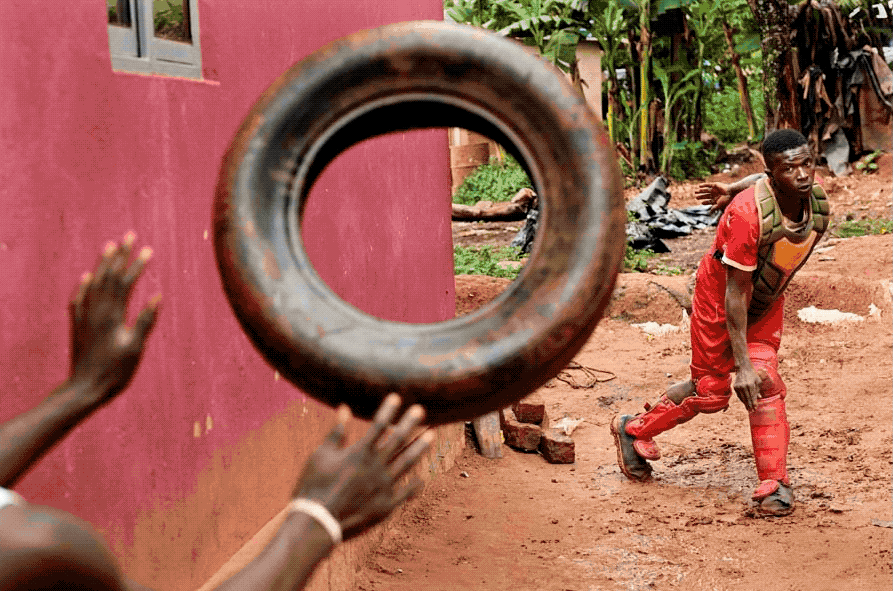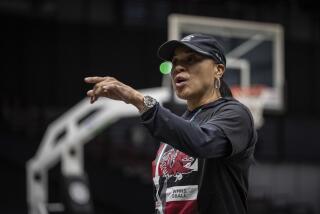SPECIAL REPORT: CRIME & SPORTS â95 : TIME OF TURMOIL : After-School Sports and Better Role Models at Home Are Considered Essential With More Young Black Men Turning to Life of Crime
Drugs, gangs and drive-by shootings were a big part of Lamar Shulerâs environment while he was growing up in Arleta and Pacoima in the San Fernando Valley. Eventually, after that kind of exposure, crime became part of Shulerâs life.
And Shuler became part of the criminal justice system that claims young African American men at alarming rates. Multiple criminal offenses helped put Shuler, 17, in Malibu Kilpatrick, an L.A. County boarding school for youths convicted of crimes.
That is a recurring theme involving black males and crime. No matter the group or study, statistics on the subject tell a grim story. The Sentencing Project, a Washington (D.C.) criminal justice think tank, found recently that more than 30% of black men 20-29 were in prison, on probation or on parole at any one time in 1995.
That represented a 23% increase from only five years ago. Whites made up 6.7% of the system and Latinos slightly more than 12%.
But something happened to change Shulerâs story for the better. Through athletics he found hope--and a chance to survive.
A senior wide receiver-defensive back for the Mustangs, Shuler has attracted attention from several colleges. He has recruiting trips scheduled to Washington University of St. Louis, and has been contacted by Morehouse of Atlanta and Howard of Washington, D.C. Shuler is scheduled to be released from Kilpatrick on Feb. 17. He is determined to avoid the fate of countless other young black males.
âI was arrested for grand theft auto, one week after being arrested for fighting,â he said. âI was just hanging around the wrong people and the wrong crowd. I just want to go to school and have a chance.
âI know of some people who have gone from here and are in college. I want to be like them.â
Sociological factors have spawned a crisis in America, leading to the incarceration of a disproportionate number of young black men. Unquestionably, athletics help some break the insidious cycle, coaches, sociologists and former athletes said, and they agree that the decrease in funding that schools are receiving for sports is eliminating that opportunity for children at a young age.
But participation in sports is hardly a cure-all. Even those who succeed at the college or professional level sometimes find the transition to a predominantly white world difficult.
Don McPherson has witnessed life in economically deprived communities first-hand. A former star quarterback at Syracuse who played with the Philadelphia Eagles and Houston Oilers, McPherson now works with Athletes in Service to America, a national program stressing violence prevention and academic success for current and former college athletes. It is McPhersonâs experience that most young black men view sports or crime as their only options.
âYou either play a sport where you can possibly make money or you go and do something in which you know youâre going to make money,â McPherson said. âUnfortunately, going to do something at a young age where you know youâre going to make [a lot of] money is usually illegal--especially in the inner city. Fewer young black men are seeing ways to earn an honest living in their communities.
âThere are fewer black men who have succeeded who live in the âhood; fewer who live there so young black men can see the evidence that if you go to school and you live an honest life, you can make an honest living. Not enough young black men see that, and the alternative is the street life.â
One problem several educators cite is that many black males are raised in single-parent households, mostly headed by women. In California, 45% of African American households include married couples, compared to 67% for whites and 77% for Latinos, according to a 1990 U.S. Census Bureau study. Only 43% of African American males under 21 live with both parents, compared to 80% of whites and 71% of Latinos.
âMy dadâs dead, but I never knew him,â Shuler said. âI lived with my mother, then she started getting into trouble. Thatâs when I started hanging with a group that got me into trouble. Everything went down from there.â
John Reid repeatedly hears similar distressing stories. Reid, director of the Teaching Ombudsman Action Program at Cal State Fullerton, said the impact of few positive male role models is immeasurable. He encounters the negative results daily in his work with African American athletes.
âYouâre talking about young African American males who come from a family that [many times] consists of a single parent who is a female heading the household with no male role model around,â Reid said. âHe then goes out in the street with his peers, where he has got to be tough to survive.
âHeâs certainly not going to survive going out there acting like his mom. This is where you see the macho stuff coming out, the tough guy. If youâre not like that, you wonât survive. That carries over throughout their lives.â
George Raveling, former USC basketball coach and a consultant for Nike, agrees.
âWeâre all products of our environment,â Raveling said. âWhite athletes donât tend to be in as much [trouble] because they often come from dual-parent households.â
Lorenzo Romar, a UCLA assistant basketball coach, said college coaches can make a difference in lives of young black males. But Romar, who played with the Golden State Warriors and Milwaukee Bucks, said many more role models are needed.
âWhen weâre recruiting kids, we tell them we want to help them as people,â Romar said. âMaybe we can help them get some of the things that they might have missed if they donât have that father figure there.
âIf they havenât had positive male role models in their lives, we try to put them in positions where they can have that. Hopefully, in four years we can help them catch up on some of that.â
The reasons for the high Sentencing Project statistics are widely debated. Commonly identified are a suspicion that law enforcement authorities tend to disproportionately target blacks as suspects in crimes, differences in drug-sentencing guidelines and pervasive violence within poor communities.
Glenn Bell, football coach at Manual Arts High and former coach at Kilpatrick, blames some of the problems on the lack of after-school programs, including athletics, in the inner city.
âWe lose a lot of kids by the time they reach high school because they are not getting the after-school exposure to sports,â Bell said. âBecause of a lack of funding, kids have too much time on their hands. Without any sports at the feeding schools, kids are not motivated like they used to be, so they turn to other things.
âWithout sports, many kids miss the opportunity to grow as males. There are so many life values and lessons that they miss out on that they would have gained through sports.â
Another problem arises once many inner-city children reach high school, Bell said.
âIt centers around the eligibility process,â he said. âA lot of kids who need sports the most have weaker academic backgrounds.
âBecause their GPAs are [often] low, they often are not eligible to play sports. So when that happens and the one positive to keep them on the straight and narrow is taken away, they tend to start dealing with the lower crime element.â
More than 85% of those who play sports at Kilpatrick do not commit offenses after being released, school officials said. However, 75% of those under non-sports juvenile detention care are repeat offenders.
âWe have a lot of success stories of kids who have been at Kilpatrick,â said Duane Diffie, Kilpatrickâs athletic director. âBut there are some kids who have been in our program who are killed once they return home. We only have them for seven months, so what happened in their lives before they arrive sometimes comes back to haunt them.â
The harsh life many black athletes lead helps shape their perspective. Those lucky enough to reach the college level do so by beating many odds, said John Callaghan, a USC professor and expert on sports in society.
âThey have seen it all, every type of crime,â Callaghan said. âItâs a very difficult background many of them come from, but there is no question in my mind that the majority of [black athletes] make the most of the opportunities that they have in college. Very few fall, but the ones who do get all the headlines.â
Raveling said that the college experience typically poses problems for black athletes.
âWe need to teach [young black athletes] people skills,â Raveling said. âFor example, many times you have a black athlete leave his environment to attend a predominantly white university. It is usually the first time in the athleteâs life that they have to live in a dominant white environment.
âThe black athlete has to learn how to cross over and learn the difference in cultural values. Then when they do, they often donât have the necessary garments--and Iâm not necessarily talking about clothes--to make them feel like they belong. It is a social phenomenon.â
That does potentially horrific emotional damage to black athletes, McPherson believes.
âIf you go from an environment where youâre not getting a lot in terms of favors, and not getting a lot in terms of consideration from the âwhite society,â and you go to a place that is predominantly white and you are being hailed as someone special, there definitely is a change that takes place,â he said. âYou get used to that kind of treatment.
âItâs wonderful treatment. Itâs a wonderful life of entitlement, being a special person on campus. But when theyâre done [playing], the reality of who they are becomes a slap in the face. We all say it jokingly, and a lot of people donât realize it until their time comes, but youâre just a piece of meat.â
Reid said that black athletes are often academically unprepared to handle college course work. He said that with almost year-round commitments to athletics and without enough academic and emotional support at some universities, many black athletes leave college ill-equipped to function successfully in society. This contributes heavily to the incarceration numbers of black men, he said.
âThey leave college with no degree and no job skills,â Reid said. âTheyâre not marketable and theyâre not employable. They get into a situation where they are desperate, and desperate people do desperate things.â
Another hurdle black athletes face is the growing perception by white America that they commit more crimes, educators said. A 1990 study by the National Opinion research center showed that 56% of nonblacks believed blacks are more violent.
âI have not seen such a study that would prove [black athletes commit more crimes],â said Richard Lapchick, director of Northeasternâs Center for the Study of Sport in Society. âIâm not saying that itâs not possible that someone might do a study that actually shows this, but up to this point [people] are reaching a conclusion based on no such study.
âI think itâs part of the whole demonization of athletes going on in the country. We are trying, generally speaking, to say athletes are more inclined to use drugs, more inclined to commit violent crimes. There has never been any study that proves that to be true. Whatâs happened is people take a lot of anecdotal evidence and form opinions. So it certainly forms a picture to the general public that there must be a problem here when they see that.â
David Wiggins, a sociology professor at George Mason University and author of several books dealing with the history of black athletes, agrees.
â . . . I truly believe that the perception is that black athletes engage in more violent crimes,â he said. âThere is a long legacy of this stereotype.â
Of the 345 athletes who appeared in newspaper stories about crime in 1995 in a survey conducted by The Times, a large number were African American. At first glance, that would seem to confirm that black athletes commit more crimes. But the numbers are misleading.
African Americans dominate two of Americaâs most followed and covered sports--football and basketball. Although blacks make up only 12.5% of the nationâs population, they make up 75% of the NBA and 60% of the NFL. Blacks make up 64% of college basketball players and nearly 40% of college football players.
âAt some point, people need to wake up and understand we have a very, very racist society,â said Harry Edwards, a professor at the University of California and a consultant to the San Francisco 49ers. âYou cannot have a racist society and not have racism thoroughly infesting the sports structure, any more than you can have a chicken laying a duck egg.
âUntil we start dealing with those fundamental factors, problems will always exist.â
(BEGIN TEXT OF INFOBOX / INFOGRAPHIC)
A Look at Percentages
African Americans dominate two of Americaâs most followed and covered sports--football and basketball. Although African Americans make up only 12.5% of the nationâs population, they make up 75% of the NBA and 60% of the NFL. They make up 64% of college basketball players and nearly 40% of all college football players.
75% of the NBA
60% of the NFL
64% of College Basketball
40% of College Football
More to Read
Go beyond the scoreboard
Get the latest on L.A.'s teams in the daily Sports Report newsletter.
You may occasionally receive promotional content from the Los Angeles Times.










